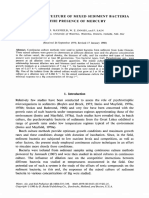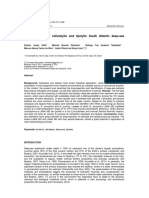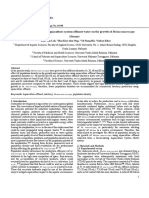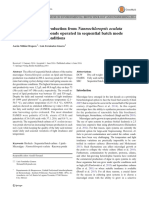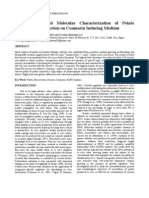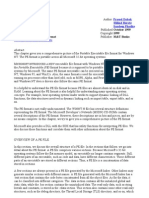Factors Indicating Culture Status During Cultivation of
Factors Indicating Culture Status During Cultivation of
Uploaded by
ilaboratorCopyright:
Available Formats
Factors Indicating Culture Status During Cultivation of
Factors Indicating Culture Status During Cultivation of
Uploaded by
ilaboratorOriginal Title
Copyright
Available Formats
Share this document
Did you find this document useful?
Is this content inappropriate?
Copyright:
Available Formats
Factors Indicating Culture Status During Cultivation of
Factors Indicating Culture Status During Cultivation of
Uploaded by
ilaboratorCopyright:
Available Formats
The Journal of Microbiology, April 2007, p.
122-127 Copyright 2007, The Microbiological Society of Korea
Vol. 45, No. 2
Factors Indicating Culture Status During Cultivation of Spirulina (Arthrospira) platensis
Choong-Jae Kim, Yun-Ho Jung, and Hee-Mock Oh*
Environmental Biotechnology Research Center, Korea Research Institute of Bioscience and Biotechnology, Daejeon 305-806, Republic of Korea (Received January 15, 2007 / Accepted March 5, 2007)
Factors indicating culture status of two Spirulina platensis strains were monitored in a batch mode cultivation for 36 days. Changing mode in all factors showed a common turning point, indicating shift of cell or culture status. Mean biomass productivity was highly sustained until day 22, chlorophyll a concentration peaked on day 22, pH value was >12 on day 22, coil number was abruptly shortened on day 22, and floating activity was sustained at greater than 79% after day 22, indicating that day 22 is a criterion reflecting phase-transfer in cell physiology in a batch culture system. Many of these changes may have been caused by increased pH, suggesting that pH control is essential for mass production of S. platensis. Fluctuations in floating activity were likely induced by the number of cellular gas vacuoles. Consequently, coil number per trichome and floating activity of S. platensis could readily act as simple indicators for determination of culture status or harvesting time of cells. Keywords: coil number, culture status, cyanobacteria, floating activity, Spirulina platensis
Photosynthetic cyanobacterium Spirulina platensis (Arthrospira platensis) has been cultivated for mass production in many countries in tropic, subtropical and temperate regions for use in human health food (Ciferri, 1983; Belay et al., 1993), as an animal feed additive (Belay et al., 1996; Lu et al., 2002), and for colorimetric use (Dainippon Ink and Chemicals, 1985), making it one of the most commercialized microalgae. To produce high quality biomass, much attention must be paid to culture status. Generally, in cultivation of cells, dry cell weight has been used to obtain information on cell growth with respect to biomass productivity or specific growth rate. Chlorophyll a concentration can also be used to determine cell activity and has even been used in remote estimation for determination of harvesting time and nutrient addition time in outdoor cultivation of S. platenesis (Gitelson et al., 1995). The pH value of the culture medium combined with dry cell weight may be a simpler, indirect method for determining the degree of the cell growth of S. platensis. This is because the pH gradually rises as bicarbonate added to the culture medium is dissolved to produce CO2, which releases OH- during cultivation of S. platensis (Richmond and Grobbelaar, 1986). However, because the increased pH acts as an autoinhibitor of cell growth, it has been suggested that controlling the pH of the culture medium is necessary (Richmond, 2000). Additionally, coil number per trichome (or trichome length) and floating activity may be important factors for determining cell growth, as they affect harvesting efficiencies and indicate cell status. The former may indicate filtration efficiency, because trichomes that have been shortened too much pass
To whom correspondence should be addressed. (Tel) 82-42-860-4321; (Fax) 82-42-860-4594 (E-mail) heemock@kribb.re.kr
through a filter screen, whereas the latter is related to collection efficiency of the cells. The gas vacuole is an essential organ that provides buoyancy, allowing microorganisms to position themselves for various reasons, including photosynthesis (see Walsby, 1994). Floating activity (buoyancy) is dominantly governed by light intensity (Walsby, 1969; Walsby, 1971; Dinsdale and Walsby, 1972); however, it may also follow a changing pattern based on responses in physiological conditions of the cells under a batch culture mode, with cellular ultrastructural changes in gas vacuoles (or vesicles). Therefore, both coil number and floating activity may also act as harvesting indicators. In this study, the relatedness between the above mentioned factors and cells status were monitored to determine the optimal harvesting time in relation to biomass production of S. platensis cells, with observation of the cellular ultrastructure of the gas vacuole in respect to floating activity. Additionally, the effects of pH of the culture medium on cell growth and coil number were examined.
Materials and Methods
Strains NIES 46 and 39 of S. platensis were provided by the National Institute for Environmental Studies, Japan. The strains were cultivated in 9 L glass jar culture vessels containing 6 L SOT medium (Zarouk, 1966) based on distilled 2 water under continuous light at 180 mol photons/m /s using cylindrical white bulbs at room temperature (252C) for 36 days. The culture was stirred using a magnetic stirrer and mixed using an air bubbler (1 L/min). Dry cell weight, chlorophyll a concentration, coil number, and floating activity of S. platensis, as well as pH of the medium were measured every 2 days. The mean values of these factors were ob-
Strain and cultivation
Vol. 45, No. 2
Factors indicating status of Spirulina
123
tained in triplicate except for pH, which was determined based on a single sample.
Dry cell weight, chlorophyll a, and pH
For dry cell weight measurement, 20 ml of culture were sampled and filtered through a GF/C filter (Whatman, UK), which was dried for 1 h at 105C and weighed prior to filtration. The filter was then washed with two volumes of distilled water, dried as above, and weighed. Ten mililiter of culture was analyzed to determine chlorophyll a concentration using 90% acetone (Strickland and Parson, 1968). Filtrated pigment exudates from the aged culture were disregarded. pH was measured using a pH meter (340, Mettler Toledo, UK).
30 trichomes counted using a microscope (Microphot-FXA, Nikon, Japan) at 20 magnification. To measure floating activity, 6 ml of culture was sampled in a translucent plastic tube, and absorbance at 680 nm was measured to determine the initial OD. The sample was then incubated under the same light intensity as the cultures. After one hour, absorbance using 1 ml sampled 2 cm from the bottom of the tube was measured as above. Calculation of the floating activity was then determined using the method described by Kim et al. (2005).
Transmission electron microscope (TEM)
Coil number and floating activity
Coil number (spiral) of S. platensis was determined by taking the average number of helical coils per trichome from
To monitor changes in the gas vacuoles with culture time, the culture was sampled on days 4, 22, and 30, based on the fluctuation of floating activity. One ml of culture was sampled and subsequent treatment for TEM observation was conducted using the method described by Lee et al. (2002).
Fig. 1. Change in factors, biomass productivity (A), chlorophyll a (B), dry cell weight (C), pH (D), coil number (E), and floating activity (F) during cultivation of Spirulina platensis. Dotted lines indicate turning time points reflecting phase-shift in the factors.
124
Kim et al.
J. Microbiol.
S. platensis growth and coil number under fixed pH condition
The effect of pH of culture medium on growth and number of coils per trichome of S. platensis was also evaluated. The NIES 39 culture was maintained in a 250 ml glass bottle containing 150 ml SOT medium (Zarouk, 1966) and agitated at 150 rpm under the same light and temperature conditions as above for 20 days. The pH of each culture was adjusted to 8.0, 8.5, 9.0, 9.5, 10.0, 10.5, 11.0, 11.5, 12.0, and 12.5 using 25% (v/v) HCl and 5 N NaOH every two days. The mean OD at 680 nm obtained from three samples was used to determine cell growth and coil number was observed and counted as above every two days. A statistical analysis using a one-way ANOVA and multiple comparison (SPSS, Ver. 10.0 for Windows) was conducted to determine if differences in growth of S. platensis NIES 39 due to pH adjustment existed. Values were considered statistically significant when P<0.05.
and activity of intra- and extracellular enzymes, as well as photosynthetic electron transport and osmotic potential of the cytoplasm (Walsby, 1982). Rapid increase of pH in culture medium is caused by mass dissociation of H2CO3 into HCO3 , which is required for rapid cell growth. Therefore, it is suggested that monitoring pH dynamics in culture medium would provide an index for determination of cell growth and status.
Coil number in a trichome
Mean coil numbers observed in both strains followed a same changing pattern, except for the initial changes within 2
Results and Discussion
Dry cell weight, chlorophyll a, and pH
The growth of S. platensis as measured by mean biomass productivity (g/L/d) based on dry cell weight was plotted (Fig. 1A). Maximum productivity was observed on day 14 in NIES 39 and day 16 in NIES 46, and these values were high until day 22, then rapidly decreased. Therefore, day 22 was considered a criterion reflecting phase-transfer of culture status in both cultures. The difference in productivity between strains decreased to nothing over time, indicating a self-shading effect. The maximum specific growth rate (max) was found on day 4 in both cultivations, with 0.50/d observed in NIES 39 and 0.59/d observed in NIES 46. Chlorophyll a concentration increased to its maximum level on day 22 in both strains, and then sharply decreased by day 26 (Fig. 1B), following the same pattern observed in biomass productivity (Fig. 1A). The increasing rate of Chlorophyll a concentration reached a maximum of 1,515 g/L/d on day 16 in NIES 46, and 1,600 g/L/d on day 20 in NIES 39. Contrary to the gentle rise observed in biomass production (Fig. 1C), chlorophyll a concentration showed obvious increase, peak and decrease over time, suggesting that it was the most sensitive factor for determination of cells status. The pH value increased to a range of 12.1 to 12.3 from day 22 to 26 in both strains, and then decreased (Fig. 1D). Day 22 corresponded with the time at which chlorophyll a concentration reached its maximum in both strains. The increasing rate of pH peaked on day 2 at 0.46 per day in NIES 39 and 0.44 per day in NIES 46, which was faster than chlorophyll a, but closer to the specific growth rate observed in dry cell weight. Based on these results, attaining the maximum pH value indicates that chlorophyll a concentration has reached its maximum and high biomass productivity will no longer be sustained, indicating that cells status of S. platensis could be preferentially dictated by pH of culture medium prior to the self-shading effect in a batch culture system. As reported previously, change in pH affects solubility and bioavailability of nutrients (Stumn and Morgan, 1981), transport of substances across cytoplasmic membranes,
Fig. 2. Transmission Electron Microscope (TEM) images showing change in gas vacuoles of Spirulina platensis cells with culture time. Cells were collected on day 2 (A), day 22 (B), and day 35 (C) from the culture. Arrow a indicates sheath, b septum, c thylacoid bundle, and d gas vacuoles. Scale bar=2 m.
Vol. 45, No. 2
Factors indicating status of Spirulina
125
days; then increased to reach a maximum of 8.0-9.0, which was attained until day 16, and then gradually decreased to 7.0-7.5, followed by a rapid decrease to 3.6-4.0 on day 22 (Fig. 1E). The time at which the highest number of trichomes are present is considered an indication of cells of high quality. In both cultures, rapid decrease occurred on day 22, which corresponded to changes in biomass productivity and chlorophyll a concentration. Interestingly, a rapid decrease in coil number and pH increase to greater than 12 concomitantly occurred on day 22, indicating that shortened coil number may be caused by the increased pH. As shown in Fig. 1F, floating activity initially fell to -74 in NIES 39 and -49% in NIES 46 on day 4. These values gradually increased to greater than 82% in both strains on day 22. Then, the values remained greater than 79%. Initial decreases in floating activity continued until day 4, which corresponds to the day that maximum specific growth rate was observed. The decreases in floating activity were caused by increased cell contents, such as carbohydrates observed in actively growing cells (Fig. 2A), as suggested by van Rijn and Shilo (1985). Therefore, 4 days of growth is suggested as criterion for selection of the highest quality cells. A value of greater than 79% in both strains was observed after day 22, at which time the cells already occupied a number of gas vacuoles, as shown in Fig. 2B and C, resulting in high floating activity. This high floating activity seems to be related to decrease in cellular carbohydrate that occurs with increasing culture time, as shown by Kim et al. (2005), who determined that increased floating activity was due to an increased cellular protein to carbon ratio. Floatation greater than 79% coincided with the pH levels being greater than 12.0. However, low flotation is sometimes observed under unfavorable culture conditions, such as high speed circulation, which induces collapse of the gas vacuoles. Zhao et al. (2001) reported that vacuolation was induced by unfavorable pH conditions in the cyanobacteria Anabaena sp. and Plectonema boryanum, but not in Spirulina maxima. In this study, vacuolation was always observed, regardless of pH; however, cells subjected to hostile growth conditions caused by high or low pH seemed to have accelerated vacuole production. Our results indicate that floating activity follows a constant pattern dependent on cell growth under constant light conditions in a batch mode, suggesting that cell biological status could be easily determined using floating activity.
Floating activity and TEM observation
Fig. 3. Growth (A), change in pH of culture medium (B), and change in coil number per trichome (C) of Spirulina platensis under fixed pH conditions. Values of (A) and (B) are means of triplicates SD, and those of (C) are means of 30 trichomes SD.
S. platensis growth and coil number under fixed pH condition
As suggested above, increased pH of culture medium seemed to suppress growth of S. platensis, however, it is not clear whether increased pH invokes a cell physiological response leading to retarded cell growth. Therefore, effects of different pH on cell growth and coil number per trichome was evaluated. The mean OD values of the cultures grown at different pH levels reached maximum levels on day 20 with a range of 0.2 to 8.1. pH conditions greater than 11.5 resulted in a lower mean OD than that of the control (not fixed). The
mean OD value at a fixed pH of 12.5 was significantly lower than that of the control (P<0.05) (Fig. 3A). Conversely, a fixed pH less than 10.5 resulted in a higher mean OD than that of the control. The maximum OD value was observed at a fixed pH of 9.5, which was significantly greater than that of the control (P0.001) (Fig. 3A). Additionally, the next highest OD value was observed at a fixed pH of 10, however this difference was not significant (P>0.05, data not shown). At pH 9.5, the mean OD value was 1.3-2.7 times greater (mean 2.3 times) than those of the control. A fixed pH of 8.0-10.5 resulted in a mean OD value at day 20 that was greater than 1.5 times that of the control.
126
Kim et al.
J. Microbiol.
The pH change in culture medium at a fixed pH of 9.5 and 12.5 under control conditions (not fixed) is shown in Fig. 3B. The pH of the control culture was greater than 12 on day 14, after a rapid initial increase, similar to the pattern depicted in Fig. 1D. Contrary to the control condition, at a fixed pH of 9.5 OD steadily increased, whereas at a fixed pH of 12.5 decreased until day 10, then increased with fluctuations. The pH and mean OD value at a fixed pH of 9.5 sharply increased (Fig. 3B) and decreased (Fig. 3A), respectively on day 18, however, this was after the pH was not controlled one time on day 16. Therefore, it is concluded that increases in pH during cultivation can remarkably inhibit S. platensis growth, and pH control is a prerequisite for improvement of biomass production. Spirulina species are capable of maintaining an internal constant pH as reported by Belkin and Boussiba (1991), who demonstrated that at an external pH of 10.0 and 11.5, the intracellular pH was only 8.0 and 8.5, respectively. Based on the results of this study, however, an external pH of greater than 10.5 seemed to cause the slow collapse of internal pH homeostasis, especially with regard to sodium depletion, as suggested by Schlesinger et al. (1996). Change in coil number per trichome under differing pH conditions with control followed a pattern of initial increase, reaching a maximum between days 8 and 12 with a range of 6.8-9.8 coils per trichome, followed by decrease. This pattern was not observed in cultures fixed at a pH of 11.5 to 12.5, which sustained low coil numbers with low variation throughout cultivation (Fig. 3C). In the control, coil number per trichome gradually increased to a maximum of 9.2 coils on day 10, thereafter decreasing to 3.5 coils on day 20. At a fixed pH of 9.5, coil number reached a maximum of 9.2 coils on day 8, 2 days sooner than in the control, and thereafter decreased (while remaining at a level greater than that of the control) to 5.4-5.9 from day 18 to 20. As shown in Fig. 3B and 3C, pH of the culture medium acted as a major factor affecting coil number per trichome, which may indicate cells status and help determine harvesting time. In this study, changes in general properties, such as dry cell weight and chlorophyll a, were used to monitor cells status and determine appropriate harvest time of S. platensis. When these properties were compared with pH of medium, floating activity, and coil number per trichome, a common point of change (day 22) was observed, most obviously in chlorophyll a concentration and floating activity. Floating activity could therefore be used as a simple indicator for determination of cell status or harvesting time. Furthermore, changes in factors evaluated in this study will provide useful information for modeling cultivation of S. platensis. Increased pH controlled cell growth, as indicated by chlorophyll a concentration, trichome length and floating activity. Therefore, control of pH in culture medium will be one of the most critical factors affecting biomass production of S. platensis. It should be noted that culture status can be affected by other culture conditions not addressed by this study, such as temperature variation and the selfshading effect that occurs in cultures over time, however changes of the culture status will follow a constant mode, similar to what was observed in this study. Cell quality, biomass productivity and economic balances
should be considered when determining adequate harvesting time of S. platensis. This study indicated that observation of changes in several factors over time can act as the criteria for harvesting and culture management of S. platensis.
Acknowledgement
This research was supported by a grant (code DC2-101) from the Carbon Dioxide Reduction & Sequestration Research Center, a 21st Century Frontier Program funded by the Korean Ministry of Science and Technology.
References
Belay, A., T. Kato, and Y. Ota. 1996. Spirulina (Arthrospira): potential application as an animal feed supplement. J. Appl. Phycol. 8, 303-311. Belay, A., Y. Ota, K. Miyakawa, and H. Shimamatsu. 1993. Current knowledge on potential health benefits of Spirulina. J. Appl. Phycol. 5, 235-241. Belkin, S. and S. Boussiba. 1991. Resistance of Spirulina platensis to ammonia at high pH values. Plant Cell Physiol. 32, 953-958. Ciferri, O. 1983. Spirulina, the edible micro-organism. Microbiol. Rev. 47, 551-578. Dainippon Ink and Chemicals. 1985. Lina Blue A (Natural blue colorant of Spirulina origin). Technical information Dainippon Ink and Chemicals, Tokyo, Japan. Dinsdale, M.T. and A.E. Walsby. 1972. The interrelations of cell turgor pressure, gas-vacuolation, and buoyancy in a blue-green alga. J. Exp. Bot. 23, 561-570. Gitelson, A., S. Laorawat, G.P.P. Keydan, and A. Vonshak. 1995. Optical properties of dense algal cultures outdoors and its application to remote estimation of biomass and pigment concentration in Spirulina platensis. J. Phycol. 31, 828-834. Kim, S.G., A. Choi, C.Y. Ahn, C.S. Park, Y.H. Park, and H.M. Oh. 2005. Harvesting of Spirulina platensis by cellular flotation and growth stage determination. Lett. Appl. Microbiol. 40, 190194. Lee, S.H., T. Motomura, and T. Ichimura. 2002. Light and electron microscopic observations of preferential destruction of chloroplast and mitochondrial DNA at early male gametogenesis of the anisogamous green alga Derbesia tenuissima (Chlorophyta). J. Phycol. 38, 534-542. Lu, J., G. Yoshizaki, K. Sakai, and T. Takeuchi. 2002. Acceptability of raw Spirulina platensis by larval tilapia Oreochromis niloticus. Fish. Sci. 68, 51-58. Richmond, A. 2000. Microalgal biotechnology at the turn of the millennium: A personal view. J. Appl. Phycol. 12, 441-451. Richmond, A. and J.U. Grobbelaar. 1986. Factors affecting the output rate of Spirulina platensis with reference to mass cultivation. Biomass 10, 253-264. Schlesinger, P., S. Belkin, and S. Boussiba. 1996. Sodium deprivation under alkaline conditions causes rapid death of the filamentous cyanobacterium Spirulina platensis. J. Phycol. 32, 608613. Strickland, J.D.H. and T.R. Parson. 1968. A Practical Handbook of Seawater Analysis. Fisheries Research Board of Canada, Ottawa, Canada. Stumn, W. and J.J. Morgan. 1981. Aquatic Chemistry. 2nd (ed.), Wiley, New York, USA. van Rijn, J. and M. Shilo. 1985. Carbohydrate fluctuations, gas vacuolation, and vertical migration of scum-forming cyanobacteria in fish ponds. Limnol. Oceanogr. 30, 1219-1228. Walsby, A.E. 1969. The permeability of blue-green algal gas vacuole membranes to gas. Proc. R. Soc. London Ser. B 173, 235-255.
Vol. 45, No. 2 Walsby, A.E. 1971. The pressure relationships of gas vacuoles. Proc. R. Soc. London Ser. B 178, 301-326. Walsby, A.E. 1982. Cell-water and cell-solute relations. p 237-262. In N.G. Carr and B.A. Whitton (eds), The Biology of Cyanobacteria, Blackwell Science Publications, Oxford. Walsby, A.E. 1994. Gas Vesicles. Microbiol. Rev. 58, 94-144. Zarouk, C. 1966. Contribution a letude dune cyanophycee. Influence
Factors indicating status of Spirulina
127
de divers facteurs physiques et chimiques sur la croissance et la photosynthese de Spirulina maxima (Setch. Et Gardner) Geitler. Ph. D. thesis, University of Paris, France. Zhao, Y., H. Wu, H. Guo, M. Xu, K. Cheng, and H. Zhu. 2001. Vacuolation induced by unfavorable pH in cyanobacteria. Prog. Nat. Sci. 11, 934-936.
You might also like
- Industrial Microbiology Lab 1 (BTC4205)No ratings yetIndustrial Microbiology Lab 1 (BTC4205)23 pages
- 13 Schwarz Et Al Do Algae Cause Growth-Promoting Effects p161-170No ratings yet13 Schwarz Et Al Do Algae Cause Growth-Promoting Effects p161-17010 pages
- Li Et Al. - 2006 - Awns Play A Dominant Role in Carbohydrate Production During The Grain-Filling Stages in Wheat (Triticum Aestivum)No ratings yetLi Et Al. - 2006 - Awns Play A Dominant Role in Carbohydrate Production During The Grain-Filling Stages in Wheat (Triticum Aestivum)10 pages
- Comparative Study of Microalgae Samples From Nepal For Bio-Fuel PotentialsNo ratings yetComparative Study of Microalgae Samples From Nepal For Bio-Fuel Potentials8 pages
- Rotifers in Ecotoxicology: A Review: Terry W. Snell L & Colin R - JanssenNo ratings yetRotifers in Ecotoxicology: A Review: Terry W. Snell L & Colin R - Janssen17 pages
- ROS in Vivo Determination and Antioxidant Responses in Rotifers Fed With Commercial Yeast or MicroalgaeNo ratings yetROS in Vivo Determination and Antioxidant Responses in Rotifers Fed With Commercial Yeast or Microalgae11 pages
- 2007 - Bioprospection of Cellulolytic and LipolyticNo ratings yet2007 - Bioprospection of Cellulolytic and Lipolytic11 pages
- Journal of Photochemistry and Photobiology B: BiologyNo ratings yetJournal of Photochemistry and Photobiology B: Biology8 pages
- The Effects of Recirculating Aquaculture System Effluent Water On The Growth of Moina Macrocopa (Straus)No ratings yetThe Effects of Recirculating Aquaculture System Effluent Water On The Growth of Moina Macrocopa (Straus)8 pages
- Millán Oropeza Fernández Linares2017 - Article - BiomassAndLipidProductionFromN PDFNo ratings yetMillán Oropeza Fernández Linares2017 - Article - BiomassAndLipidProductionFromN PDF9 pages
- The Cell Composition of Nannochloropsis Sp. Changes Under Different Irradiances in Semicontinuous CultureNo ratings yetThe Cell Composition of Nannochloropsis Sp. Changes Under Different Irradiances in Semicontinuous Culture5 pages
- Culture System For Wolffia Globosa L. (Lemnaceae) For Hygiene Human FoodNo ratings yetCulture System For Wolffia Globosa L. (Lemnaceae) For Hygiene Human Food20 pages
- Developmental InƒPuence of in Vitro Light Quality andNo ratings yetDevelopmental InƒPuence of in Vitro Light Quality and4 pages
- Roduction of Asiaticoside From Centella Entella Asiatica Rban Cells in BioreactorNo ratings yetRoduction of Asiaticoside From Centella Entella Asiatica Rban Cells in Bioreactor5 pages
- Cellulose-based Hydrogels as Body Water RetainersNo ratings yetCellulose-based Hydrogels as Body Water Retainers7 pages
- Effect of Nitrogen and Phosphate On The Levels of YeastNo ratings yetEffect of Nitrogen and Phosphate On The Levels of Yeast9 pages
- The Effects of Different Substrates On The Growth, Yield, and Nutritional Composition of Two Oyster Mushrooms (Pleurotus Ostreatus and Pleurotus Cystidiosus)No ratings yetThe Effects of Different Substrates On The Growth, Yield, and Nutritional Composition of Two Oyster Mushrooms (Pleurotus Ostreatus and Pleurotus Cystidiosus)16 pages
- Semicontinuous Cultivation of The Cyanobacterium Spirulina Platensis in A Closed PhotobioreactorNo ratings yetSemicontinuous Cultivation of The Cyanobacterium Spirulina Platensis in A Closed Photobioreactor7 pages
- Effect of Mixing On The Solid-State Fermentation of Coffee Pulp With Aspergillus TamariiNo ratings yetEffect of Mixing On The Solid-State Fermentation of Coffee Pulp With Aspergillus Tamarii5 pages
- Physiological Studies of Subtropical Mangrove ThraustochytridsNo ratings yetPhysiological Studies of Subtropical Mangrove Thraustochytrids8 pages
- Stationary Phase and The Cell Cycle of Dictyostelium Discoideum in Liquid Nutrient MediumNo ratings yetStationary Phase and The Cell Cycle of Dictyostelium Discoideum in Liquid Nutrient Medium11 pages
- Applied and Environmental Microbiology 2000 Nichols 2422.fullNo ratings yetApplied and Environmental Microbiology 2000 Nichols 2422.full8 pages
- Hydrogen Production From Food Waste in Anaerobic Mesophilic and Thermophilic AcidogenesisNo ratings yetHydrogen Production From Food Waste in Anaerobic Mesophilic and Thermophilic Acidogenesis9 pages
- Genetic Diversity of Total, Active and Culturable Marine Bacteria in Coastal SeawaterNo ratings yetGenetic Diversity of Total, Active and Culturable Marine Bacteria in Coastal Seawater11 pages
- An Intensive Continuous Culture System Using Tubular Photobioreactors For Producing MicroalgaeNo ratings yetAn Intensive Continuous Culture System Using Tubular Photobioreactors For Producing Microalgae13 pages
- Effect of Magnetic Field On Peroxidase Activities of Soybean Tissue CultureNo ratings yetEffect of Magnetic Field On Peroxidase Activities of Soybean Tissue Culture6 pages
- Biodegradation of Polyester Polyurethane by Endophytic FungiNo ratings yetBiodegradation of Polyester Polyurethane by Endophytic Fungi9 pages
- Application of Microbubbles To HydroponicsNo ratings yetApplication of Microbubbles To Hydroponics4 pages
- Bioremediation of Swine Wastewater and Biofuel Potential by Using Chlorella Vulgaris Chlamydomonas Reinhardtii and Chlamydomonas Debaryana CorrectedNo ratings yetBioremediation of Swine Wastewater and Biofuel Potential by Using Chlorella Vulgaris Chlamydomonas Reinhardtii and Chlamydomonas Debaryana Corrected20 pages
- Broth Rheology of Beta Vulgaris Cultures Growing in An Air Lift BioreactorNo ratings yetBroth Rheology of Beta Vulgaris Cultures Growing in An Air Lift Bioreactor5 pages
- (Onobrychis Viciifolia Scop.) Condensed Tannins Proteolysis byNo ratings yet(Onobrychis Viciifolia Scop.) Condensed Tannins Proteolysis by5 pages
- Astaxanthin Production From A New Strain ofNo ratings yetAstaxanthin Production From A New Strain of9 pages
- 5b. Mixed Exam-Style Questions On Exponentials and Logarithms - AnswersNo ratings yet5b. Mixed Exam-Style Questions On Exponentials and Logarithms - Answers2 pages
- Addition and Subtraction Vocabulary Memory Matching GamesNo ratings yetAddition and Subtraction Vocabulary Memory Matching Games7 pages
- Assess and Develop Your Skills On Mathworks ToolsNo ratings yetAssess and Develop Your Skills On Mathworks Tools3 pages
- Physics - Speed of Sound Worksheet - CompleteNo ratings yetPhysics - Speed of Sound Worksheet - Complete3 pages
- 5 Tutorial Flight 3 - Radar Anti Ice EGPWSNo ratings yet5 Tutorial Flight 3 - Radar Anti Ice EGPWS45 pages
- Be - Computer Engineering - Semester 3 - 2023 - December - Computer Graphicsrev 2019 C SchemeNo ratings yetBe - Computer Engineering - Semester 3 - 2023 - December - Computer Graphicsrev 2019 C Scheme1 page
- Forecasting Exchange Rates Using Time Series Analysis: The Sample of The Currency of KazakhstanNo ratings yetForecasting Exchange Rates Using Time Series Analysis: The Sample of The Currency of Kazakhstan8 pages
- Golf Ball Golf Woods Irons Hybrids Putters: MaterialsNo ratings yetGolf Ball Golf Woods Irons Hybrids Putters: Materials3 pages
- Matter Waves: A Moving Body Behaves in Certain Ways As Though It Has A Wave Nature100% (1)Matter Waves: A Moving Body Behaves in Certain Ways As Though It Has A Wave Nature4 pages
- 13 Schwarz Et Al Do Algae Cause Growth-Promoting Effects p161-17013 Schwarz Et Al Do Algae Cause Growth-Promoting Effects p161-170
- Li Et Al. - 2006 - Awns Play A Dominant Role in Carbohydrate Production During The Grain-Filling Stages in Wheat (Triticum Aestivum)Li Et Al. - 2006 - Awns Play A Dominant Role in Carbohydrate Production During The Grain-Filling Stages in Wheat (Triticum Aestivum)
- Comparative Study of Microalgae Samples From Nepal For Bio-Fuel PotentialsComparative Study of Microalgae Samples From Nepal For Bio-Fuel Potentials
- Rotifers in Ecotoxicology: A Review: Terry W. Snell L & Colin R - JanssenRotifers in Ecotoxicology: A Review: Terry W. Snell L & Colin R - Janssen
- ROS in Vivo Determination and Antioxidant Responses in Rotifers Fed With Commercial Yeast or MicroalgaeROS in Vivo Determination and Antioxidant Responses in Rotifers Fed With Commercial Yeast or Microalgae
- 2007 - Bioprospection of Cellulolytic and Lipolytic2007 - Bioprospection of Cellulolytic and Lipolytic
- Journal of Photochemistry and Photobiology B: BiologyJournal of Photochemistry and Photobiology B: Biology
- The Effects of Recirculating Aquaculture System Effluent Water On The Growth of Moina Macrocopa (Straus)The Effects of Recirculating Aquaculture System Effluent Water On The Growth of Moina Macrocopa (Straus)
- Millán Oropeza Fernández Linares2017 - Article - BiomassAndLipidProductionFromN PDFMillán Oropeza Fernández Linares2017 - Article - BiomassAndLipidProductionFromN PDF
- The Cell Composition of Nannochloropsis Sp. Changes Under Different Irradiances in Semicontinuous CultureThe Cell Composition of Nannochloropsis Sp. Changes Under Different Irradiances in Semicontinuous Culture
- Culture System For Wolffia Globosa L. (Lemnaceae) For Hygiene Human FoodCulture System For Wolffia Globosa L. (Lemnaceae) For Hygiene Human Food
- Developmental InƒPuence of in Vitro Light Quality andDevelopmental InƒPuence of in Vitro Light Quality and
- Roduction of Asiaticoside From Centella Entella Asiatica Rban Cells in BioreactorRoduction of Asiaticoside From Centella Entella Asiatica Rban Cells in Bioreactor
- Effect of Nitrogen and Phosphate On The Levels of YeastEffect of Nitrogen and Phosphate On The Levels of Yeast
- The Effects of Different Substrates On The Growth, Yield, and Nutritional Composition of Two Oyster Mushrooms (Pleurotus Ostreatus and Pleurotus Cystidiosus)The Effects of Different Substrates On The Growth, Yield, and Nutritional Composition of Two Oyster Mushrooms (Pleurotus Ostreatus and Pleurotus Cystidiosus)
- Semicontinuous Cultivation of The Cyanobacterium Spirulina Platensis in A Closed PhotobioreactorSemicontinuous Cultivation of The Cyanobacterium Spirulina Platensis in A Closed Photobioreactor
- Effect of Mixing On The Solid-State Fermentation of Coffee Pulp With Aspergillus TamariiEffect of Mixing On The Solid-State Fermentation of Coffee Pulp With Aspergillus Tamarii
- Physiological Studies of Subtropical Mangrove ThraustochytridsPhysiological Studies of Subtropical Mangrove Thraustochytrids
- Stationary Phase and The Cell Cycle of Dictyostelium Discoideum in Liquid Nutrient MediumStationary Phase and The Cell Cycle of Dictyostelium Discoideum in Liquid Nutrient Medium
- Applied and Environmental Microbiology 2000 Nichols 2422.fullApplied and Environmental Microbiology 2000 Nichols 2422.full
- Hydrogen Production From Food Waste in Anaerobic Mesophilic and Thermophilic AcidogenesisHydrogen Production From Food Waste in Anaerobic Mesophilic and Thermophilic Acidogenesis
- Genetic Diversity of Total, Active and Culturable Marine Bacteria in Coastal SeawaterGenetic Diversity of Total, Active and Culturable Marine Bacteria in Coastal Seawater
- An Intensive Continuous Culture System Using Tubular Photobioreactors For Producing MicroalgaeAn Intensive Continuous Culture System Using Tubular Photobioreactors For Producing Microalgae
- Effect of Magnetic Field On Peroxidase Activities of Soybean Tissue CultureEffect of Magnetic Field On Peroxidase Activities of Soybean Tissue Culture
- Biodegradation of Polyester Polyurethane by Endophytic FungiBiodegradation of Polyester Polyurethane by Endophytic Fungi
- Bioremediation of Swine Wastewater and Biofuel Potential by Using Chlorella Vulgaris Chlamydomonas Reinhardtii and Chlamydomonas Debaryana CorrectedBioremediation of Swine Wastewater and Biofuel Potential by Using Chlorella Vulgaris Chlamydomonas Reinhardtii and Chlamydomonas Debaryana Corrected
- Broth Rheology of Beta Vulgaris Cultures Growing in An Air Lift BioreactorBroth Rheology of Beta Vulgaris Cultures Growing in An Air Lift Bioreactor
- (Onobrychis Viciifolia Scop.) Condensed Tannins Proteolysis by(Onobrychis Viciifolia Scop.) Condensed Tannins Proteolysis by
- Modified Atmosphere Packaging and Blue Led For Shrimp Shelf LifeFrom EverandModified Atmosphere Packaging and Blue Led For Shrimp Shelf Life
- 5b. Mixed Exam-Style Questions On Exponentials and Logarithms - Answers5b. Mixed Exam-Style Questions On Exponentials and Logarithms - Answers
- Addition and Subtraction Vocabulary Memory Matching GamesAddition and Subtraction Vocabulary Memory Matching Games
- Be - Computer Engineering - Semester 3 - 2023 - December - Computer Graphicsrev 2019 C SchemeBe - Computer Engineering - Semester 3 - 2023 - December - Computer Graphicsrev 2019 C Scheme
- Forecasting Exchange Rates Using Time Series Analysis: The Sample of The Currency of KazakhstanForecasting Exchange Rates Using Time Series Analysis: The Sample of The Currency of Kazakhstan
- Golf Ball Golf Woods Irons Hybrids Putters: MaterialsGolf Ball Golf Woods Irons Hybrids Putters: Materials
- Matter Waves: A Moving Body Behaves in Certain Ways As Though It Has A Wave NatureMatter Waves: A Moving Body Behaves in Certain Ways As Though It Has A Wave Nature






